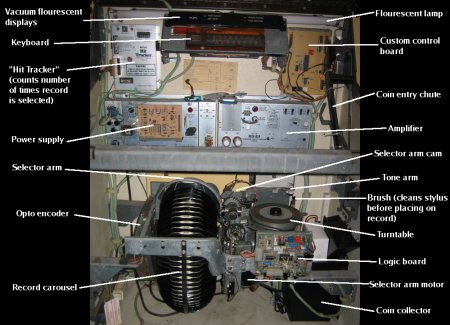A number of people have expressed an interest in this project so I have released the code as open source on GitHub. I have also created a Google Group for discussion of all things related to Rock-Ola 477 juke boxes and other similar boxes - if you have any questions I suggest posting them there, where they will receive a wider audience, rather than contacting me direct.
I'm told that the following Facebook groups are also worth a visit if you happen to use Facebook: "Rock-Ola Jukebox Club", "Rock-Ola Jukebox Collectors", "Jukebox Repair Help".
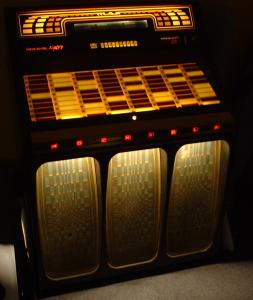
The Rock-Ola 477 was made during 1978 and 1979 and was amongst the early solid state jukeboxes. When I bought mine in 1999 it had no working features at all. Since then I've repaired all the broken electronics, installed a new PIC based control system, polished it up a bit and most recently created a web based control system so records can be selected from anywhere on the internet - the sound being streamed back to the listener.
Most of the faults that were present in the jukebox could be easily repaired. Firstly it simply needed a good clean. I took out the glass and washed it seperatly and scraped the dust off of everything else. I ordered the manuals from Victory Glass and while I waited for them to arrive I bought a new cartridge and stylus and installed some new flourescent lights. No sound appeared to come out when I tapped the stylus but this was easily traced to a wire inside the amp that leads to the volume control but had been cut. I also stripped down and cleaned the gearbox on the carousel.
When the manuals, which are very comprehensive, arrived I was able to identify the faults that were preventing the mechanism from functioning correctly (a missing relay and a blown transistor) and replaced the parts. Shortly after this one of the power supplies blew and I replaced some parts to get that working again.
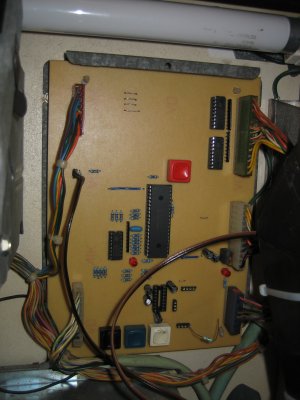
The new microcontroller system.
At this stage all that was missing was a way of selecting records. The control system and user interface takes up a number of large boards and unfortunatly use a number of chips that seem to be microprocessors with custom programs or other custom or obselete chips. There is however one chip that performs most of the mechanism control functions. I therefore decided to create a custom control circuit using a PIC16F877 microcontroller using this chip socket as an interface to the mechanism. The PIC is interfaced directly to the keyboard and vacuum flourescent displays in order to by-pass the defective user-interface board. This also allows me to implement some special custom functionality. Which is, of course, where the fun starts!
The jukebox selecting a record
After a while I thought it would be fun if I could control the juke from my PC. I'd had a thought in the back of my mind that this might be a useful thing to do while I was making the PIC board so I'd bought out the PIC serial port to a header. I soon had it connected up and was selecting records. I wasn't satisfied with that however - I then thought it would be cool if you could select a record over the internet and listen to the result via a mp3 stream. Well a bit of PHP, Javascript and Icecast hacking later I present: Rock-Ola 477 21st Century Style :-).
The PHP and Javascript webpage allows the user to select a record which is then submitted to the server as a get request. The server PHP calls a perl script which formats the correct serial command for the jukebox and fires it off. The audio is fead back into the PC from the jukebox's wallbox output and encoded and streamed by Icecast. Now all my friends can sit at home and listen to my juke (if for some reason they actually wanted to do this).
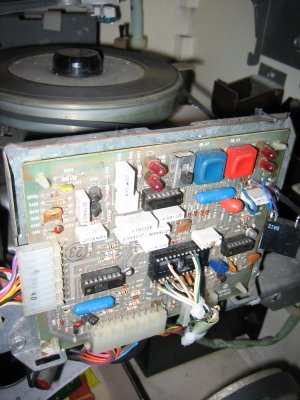
Logic board with cables from PIC board patched in place of logic chip.
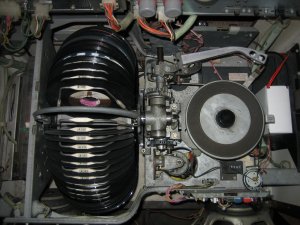
Jukebox mechanism.

Opto encoder for selecting correct record
The microswitch drops into a slot when record #1 is by the gripper.
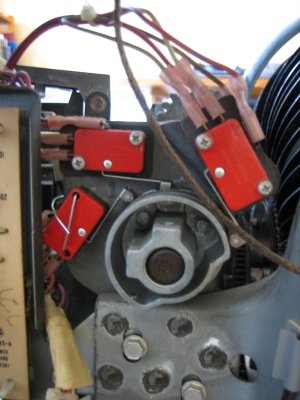
Selector arm cam and microswitches.
These are used to track the position of the selector arm as it picks up and replaces the record.
June 2006

